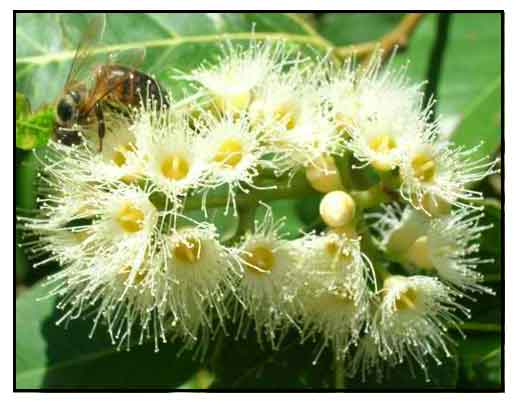|
Gen info
There are about 400 different species
sharing similar medicinal properties. (see: Eucalyptus) The genus deglupta was described and named in 1788 by the French botanist l'Héritier.

Botany
Eucalyptus deglupta is a huge evergreen tree that may attain a
height of more than 50 meters. Trunk makes up 50 to 70% of the tree height, about 250 cm diameter, with buttresses 3 to 4 meters high. Bark is smooth, yellow, orange or brown, becoming green after flaking. Twigs are 4-sided, often with 4 longitudinal wings. Young leaves are opposite, ovate to lanceolate; mature leaves are opposite to sub-opposite, rarely alternate, and short-petioled. Flowers are in 3 to 7 umbels in terminal or axillary panicles, with many white to pale yellow stamens 2 to 10 millimeters long. Fruit is pedicallate, hemispherical, with 3 to 4 valves, think, deltoid, exserted to 2 millimeters. Mature fruits are brown to dark brown, with 3 to 12 well-formed seeds per valve. Seeds are minute, brown, flattened, with a small terminal wing.
 Distribution Distribution
- In Mindanao where they are found in the lowland primary forests.
- Planted in parks and gardens in urban areas in the Philippines, but not common.
- Also occurs in Australia, Papua New Guinea, and Indonesia.
Constituents
• There are more
than 300 species. The species with the highest yield of volatile oils
are E. globosus, E. tereticornis, E. polyanthemos and E. citriodora.
• Volatile oil: phellandrene, aldehydes and ketone, 33%, phenol,
9%.
• Leaf essential oil is mainly composed of sesquiterpenoids (48%), of which E-nerolidol is the major component. (34.8%).
• Proximate analysis yielded 0.45% volatile oil, light yellow, and slightly acidic, soluble in 80% alcohol, and contains phellandrene, aldehydes, ketones, and phenols. (5)
• Methanolic extract yielded secondary metabolites such as saponins, phenols, tannins, cardiac glycosides, terpenoids, quinones, anthocyanidin, polyphenols and flavonoids. (see study below) (10)
Properties
• Stimulant, antiseptic, antimalarial, antibacterial.
• Studies have shown antibacterial, anticataract properties.
Parts
used
Leaves, oil.
 Uses Uses
Folkloric
• Antiseptic and deodorant:
Apply crushed leaves on affected area.
• Cough and asthma: Take decoction of leaves as tea.
• In other countries, used to combat malaria.
• Used as antiseptic gargle.
• Used for lung infects and bronchitis.
• Oil used for croup and spasmodic throat problems.
Others
• Oil: Used for sterilizing
and lubricating urethral catheters.
• Veterinary: In veterinary medicine, the oil used for influenza in horses,
distemper in dogs, and for parasitic skin infections and septicemia.
• Wood: The wood works well with machine and hand tools; used for furniture, molding, flooring, construction lumber, boat building, veneer and plywood.
• Fiber: Globally, most E. deglupta plantations are meant for pulp production. Used for pulp and paper products.
• Repellent: Burning of leaves used as repellent.
• Fuel: Limited use for firewood and charcoal—considered too valuable for firewood. Trees more than 15 years old yield good charcoal. Wood energy value is 18,500-21,000 kJ/kg. (12)
Studies
• Terpenoids: Dichlormethane extract of leaves yielded nerolidol (1), ursolic acid (2), oleanolic acid (3), and squalene (4), while the twigs yielded 2-4. (4)
• Pharmacognostical Study: E. deglupta yields druses of calcium oxalate crystals in the parenchyma of the midrib, petiole and stem, and occasionally in the palisade cells. The oil is of the lysigenous type. Analysis of the oil yielded 0.45% volatile oil. (see constituents above) (5)
• Xanthine Oxidase Inhibitors / Cataractogenesis Prevention: Allopurinol is a xanthine oxidase inhibitor used in the treatment of gout. In a screening study of nineteen plants, two provided varying degrees of xanthine oxidase inhibition. E. deglupta presented the best finding for cataractogenesis prevention. (6)
• Inhibition of Aldose Reductase / Prevention of Cataracts: Study screened plant extracts for aldose reductase inhibition and investigated their influence in diabetic cataractogenesis prevention in normal and diabetic Sprague Dawley rats. The best inhibitors were E. borinquensis, M. indica, E. deglupta and S. malaccense. While all of the extracts had preventive effects on the formation of cataracts, all rats treated with E. deglupta did not develop cataracts. (7)
• Essential Oil / Leaves / Antibacterial: In a study of essential oils from 15 aromatic medicinal plant species in the Democratic Republic of Congo, Eucalyptus deglupta leaf essential oil was among one of those that showed good antibacterial activity. No correlation was observed between major constituents and antibacterial activity. (8)
• Antifungal / Essential Oils: Study evaluated the chemical composition and antifungal activity of essential oils from 15 aromatic plant species in the Democratic Republic of Congo. Leaf oils of E. deglupta, E. robusta and O. gratissimum and A. stipulatum showed good activity against selected microorganisms (10-12mm). (9)
• Mosquito Larvicidal / Leaves: Study evaluated a crude leaf extract of E. deglupta for mosquito larvicidal activity on late third instar larvae of Aedes sp. Results showed pronounced larvicidal effect with longer efficacy and stability seen in the methanolic extract. (see constituents above) (10)
• Antimycobacterial / Antioxidant: Study evaluated plants from thirteen families based on traditional usage for tuberculosis and associated symptoms. Eight plants showed best antimycobacterial activity with MIC ≤ 500 µg/ml against M. tuberculosis N37Rv. E. deglupta showed an MIC of 250 µg/ml against M. tuberculosis H37Rv. E. deglupta showed major radical scavenging activity by DPPH assay with concentration of 1.33 µg/ml. (11)
Availability
- Wild-crafted.
- Ornamental planting.
|


 Distribution
Distribution Uses
Uses


